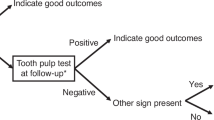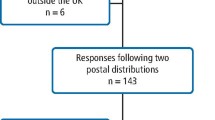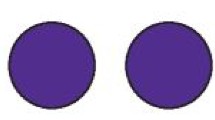Key Points
-
Explores patient and tooth variables which influence the number of clinic visits needed following traumatic dental injuries.
-
Reports the variables found to significantly influence the number of clinic visits, including distance travelled, diagnosis of a complicated hard tissue injury, and the diagnosis of a non-vital tooth.
-
Helps clinicians more accurately inform parents of the number of visits likely to be required following traumatic dental injuries.
Abstract
Objective To investigate in children the factors that influence the number of visits per tooth following traumatic dental injuries (TDI) to the permanent dentition.
Method A retrospective convenient sample of 100 children who had been treated for TDI at Leeds Dental Institute was identified. A multilevel negative binomial regression model was developed to identify factors influencing the number of visits per tooth. Data including age, gender, postcode, number of visits, treatment provided, number of teeth injured, type of periodontal and hard tissue diagnoses, healing modality, root maturity, pulp and tooth survival, and any history of previous or subsequent trauma to same tooth were analysed using SPSS 18.0 and MLWIN.
Results 186 teeth were affected by trauma in 100 patients. Median total number of visits per tooth was six visits with a range of 1-22 visits. The factors that were found to influence number of visits included: distance travelled, hard tissue diagnosis, periodontal injury diagnosis and pulp survival (P <0.05). A mile increase in distance travelled from home to clinic led to a 1.2% reduction in the number of visits per month (−0.012; SE 0.005), a diagnosis of a severe hard tissue injury was associated with 44% increase (0.362; SE 0.105) compared to no hard tissue injury, a diagnosis of a complicated periodontal injury compared to no periodontal injury was associated with a 30% increase (0.260; SE 0.124), a diagnosis of a uncomplicated periodontal injury compared to no periodontal injury was associated with a 31% increase (0.271; SE 0.124) and a diagnosis and treatment for a non-vital tooth in comparison to a vital tooth led to a 26% increase (0.230; SE 0.080) in the number of visits. There was a significant variation in the number of treatment visits at patient level (0.260; SE 0.048).
Conclusion Complicated hard tissue injuries, complicated and uncomplicated periodontal injuries, diagnosis and treatment for pulp necrosis and the distance between clinic and patient's home all significantly influenced the number of visits needed to treat TDI.
Similar content being viewed by others
Log in or create a free account to read this content
Gain free access to this article, as well as selected content from this journal and more on nature.com
or
References
Glendor U . Epidemiology of traumatic dental injuries - a 12 year review of the literature. Dent Traumatol 2008; 24: 603–611.
Chadwick B L, White D A, Morris A J, Evans D, Pitts N B . Non-carious tooth conditions in children in the UK, 2003. Br Dent J 2006; 200: 379–384.
Eilert-Petersson E, Andersson L, Sorensen S . Traumatic oral vs non oral injuries. Swed Dent J 1997; 21: 55–68.
Borum M K, Andreasen J O . Therapeutic and economic implications of traumatic dental injuries in Denmark: an estimate based on 7549 patients treated at a major trauma centre. Int J Paediatr Dent 2001; 11: 249–258.
Cortes M I, Marcenes W, Sheiham A . Impact of traumatic injuries to the permanent teeth on the oral health-related quality of life in 12-14-year-old children. Community Dent Oral Epidemiol 2002; 30: 193–198.
Porritt J M, Rodd H D, Baker S R . Quality of life impacts following childhood dento-alveolar trauma. Dent Traumatol 2011; 27: 2–9.
Thelen D S, Trovik T A, Bardsen A . Impact of traumatic dental injuries with unmet treatment need on daily life among Albanian adolescents: a case-control study. Dent Traumatol 2011; 27: 88–94.
Rodd H D, Barker C, Baker S R, Marshman Z, Robinson P G . Social judgements made by children in relation to visible incisor trauma. Dent Traumatol 2010; 26: 2–8.
Vlok J L, Worthington E M, Hindson J A, Davidson L E, Thomson W M, Drummond B K . Young people's perceptions of photographs of dental trauma. Dent Traumatol 2011; 27: 109–112.
Fakhruddin K S, Lawrence H P, Kenny D J, Locker D . Impact of treated and untreated dental injuries on the quality of life of Ontario school children. Dent Traumatol 2008; 24: 309–313.
Jackson N G, Waterhouse P J, Maguire A . Management of dental trauma in primary care: a postal survey of general dental practitioners. Br Dent J 2005; 198: 293–297.
Hamilton F A, Hill F J, Holloway P J . An investigation of dento-alveolar trauma and its treatment in an adolescent population. Part 2: dentists' knowledge of management methods and their perceptions of barriers to providing care. Br Dent J 1997; 182: 129–133.
Nguyen P M T, Kenny D J, Barrett E J . Socio-economic burden of permanent incisor replantation on children and parents. Dent Traumatol 2004; 20: 123–133.
Wong F S, Kolokotsa K . The cost of treating children and adolescents with injuries to their permanent incisors at a dental hospital in the United Kingdom. Dent Traumatol 2004; 20: 327–333.
Glendor U, Halling A, Bodin L et al. Direct and indirect time spent on care of dental trauma: a 2-year prospective study of children and adolescents. Endod Dent Traumatol 2000; 16: 16–23.
Glendor U, Marcenes W, Andreasen J O . Classification, Epidemiology and Etiology. In Andreasen J O, Andreasen F M, Andersson L, (eds). Textbook and colour atlas of traumatic injuries to the teeth. pp 217–254. 4th ed. Copenhagen: Blackwell Munksgaard, 2007.
Glendor U, Halling A, Andersson L, Eilert-Petersson E. Incidence of traumatic tooth injuries in children and adolescents in the county of Vastmanland, Sweden. Swed Dent J 1996; 20: 15–28.
Welbury R R, Kinirons M J, Day P F, Humphreys K, Gregg T A . Outcomes for root-fractured permanent incisors: a retrospective study. Paediatr Dent 2002; 24: 98–102.
Gilthorpe M S, Maddick I H, Petrie A . Introduction to multilevel modelling in dental research. Community Dent Health 2000; 17: 222–226.
Maas C J M, Hox J J . Sufficient sample sizes for multilevel modeling. Methodol 2005; 1: 86–92.
Glendor U, Jonsson D, Halling A, Lindqvist K . Direct and indirect costs of dental trauma in Sweden: a 2-year prospective study of children and adolescents. Community Dent Oral Epidemiol 2001; 29: 150–160.
Glendor U, Halling A, Andersson L, Andreasen J O, Klitz I . Type of treatment and estimation of time spent on dental trauma-a longitudinal and retrospective study. Swed Dent J 1998; 22: 47–60.
Borssen E, Kallestal C, Holm A K . Treatment time of traumatic dental injuries in a cohort of 16-year-olds in northern Sweden. Acta Odontol Scand 2002; 60: 265–270.
Al-Jundi S H . Type of treatment, prognosis, and estimation of time spent to manage dental trauma in late presentation cases at a dental teaching hospital: a longitudinal and retrospective study. Dent Traumatol 2004; 20: 1–5.
Flores M T, Andreasen J O, Bakland L K et al. Guidelines for the evaluation and management of traumatic dental injuries. Denl Traumatol 2001; 17: 145–148.
Flores M T, Andreasen J O, Bakland L K et al. Guidelines for the evaluation and management of traumatic dental injuries. Dent Traumatol 2001; 17: 193–198.
Gregg T A, Boyd D H . UK National Clinical Guidelines in Paediatric Dentistry. Treatment of avulsed permanent teeth in children. Int J Paediatr Dent 1998; 8: 75–81.
Kinirons M J . Treatment of traumatically intruded permanent incisor teeth in children. UK National Clinical Guidelines in Paediatric Dentistry. Int J Paediatr Dent 1998; 8: 165–168.
Muller H P . Dealing with hierarchical data in periodontal research. Clin Oral Investig 2009; 13: 273–278.
Zaitoun H, North S, Lee S, Albadri S, McDonnell S T, Rodd H D . Initial management of paediatric dento-alveolar trauma in the permanent dentition: a multi-centre evaluation. Br Dent J 2010; 208: E11; discussion 254–255.
Robertson A, Robertson S, Noren J G . A retrospective evaluation of traumatized permanent tooth. Int J Paediatr Dent 1997; 7: 217–226.
Andreasen J O, Borum M K, Jacobsen H L, Andreasen F M . Replantation of 400 avulsed permanent incisors 4. Factors related to periodontal ligament healing. Dent Traumatol 1995; 11: 76–89.
Tsilingaridis G, Malmgren B, Andreasen J O, Malmgren O . Intrusive luxation of 60 permanent incisors: a retrospective study of treatment and outcome. Dental Traumatol 2012; 28: 416–422.
Day P F, Kindelan S A, Spencer J, Kindelan J, Duggal M S . Dental trauma: part 2. Managing poor prognosis anterior teeth- treatment options for the subsequent space in a growing patient. J Orthod 2008; 35: 143–155.
Day P F, Gregg T A, Ashley P et al. Periodontal healing following avulsion and replantation of teeth: a multi-centre randomized controlled trial to compare two root canal medicaments. Dental Traumatol 2012; 28: 55–64.
Department of Health. Dental SIFT (service increment for teaching) accountability report. London: HMSO, 2000.
Office for National Statistics. Annual survey and hours and earnings 2010. Available online at: http://www.ons.gov.uk/ons/rel/ashe/annual-survey-of-hours-and-earnings/2010-revised-results/index.html (accessed May 2013).
Lauridsen E, Hermann N V, Gerds T A, Ahrensburg S S, Kreiborg S, Andreasen J O . Combination injuries 1. The risk of pulp necrosis in permanent teeth with concussion injuries and concomitant crown fractures. Dent Traumatol 2012; 28: 364–370
Lauridsen E, Hermann N V, Gerds T A, Ahrensburg S S, Kreiborg S, Andreasen J O . Combination injuries 2. The risk of pulp necrosis in permanent teeth with subluxation injuries and concomi-tant crown fractures. Dent Traumatol 2012; 28: 371–378.
Pradhan D P, Chawla H S, Gauba K, Goyal A . Comparative evaluation of endodontic management of teeth with unformed apices with mineral trioxide aggregate and calcium hydroxide. J Dent Child 2006; 73: 79–85.
Diangelis A J, Andreasen J O, Ebeleseder K A et al. International Association of Dental Traumatology guidelines for the management of traumatic dental injuries: 1. Fractures and luxations of permanent teeth. Dent Traumatol 2012; 28: 2–12.
Author information
Authors and Affiliations
Corresponding author
Additional information
Refereed Paper
Rights and permissions
About this article
Cite this article
Keasberry, J., Munyombwe, T., Duggal, M. et al. A study of factors that influence the number of visits following traumatic dental injuries. Br Dent J 214, E28 (2013). https://doi.org/10.1038/sj.bdj.2013.532
Accepted:
Published:
Issue date:
DOI: https://doi.org/10.1038/sj.bdj.2013.532
This article is cited by
-
The impact of accessibility and service quality on the frequency of patient visits to the primary diabetes care provider: results from a cross-sectional survey performed in six European countries
BMC Health Services Research (2020)
-
Summary of: A study of factors that influence the number of visits following traumatic dental injuries
British Dental Journal (2013)



